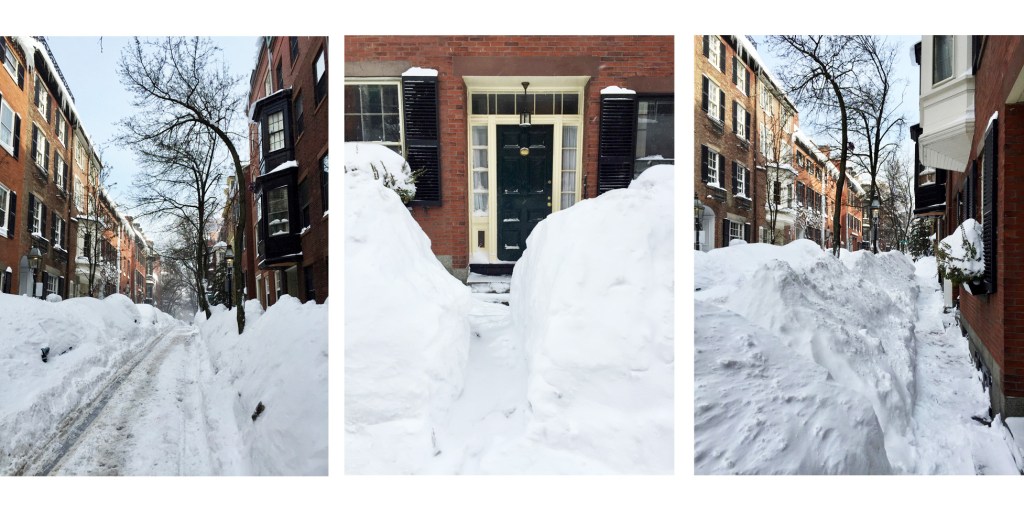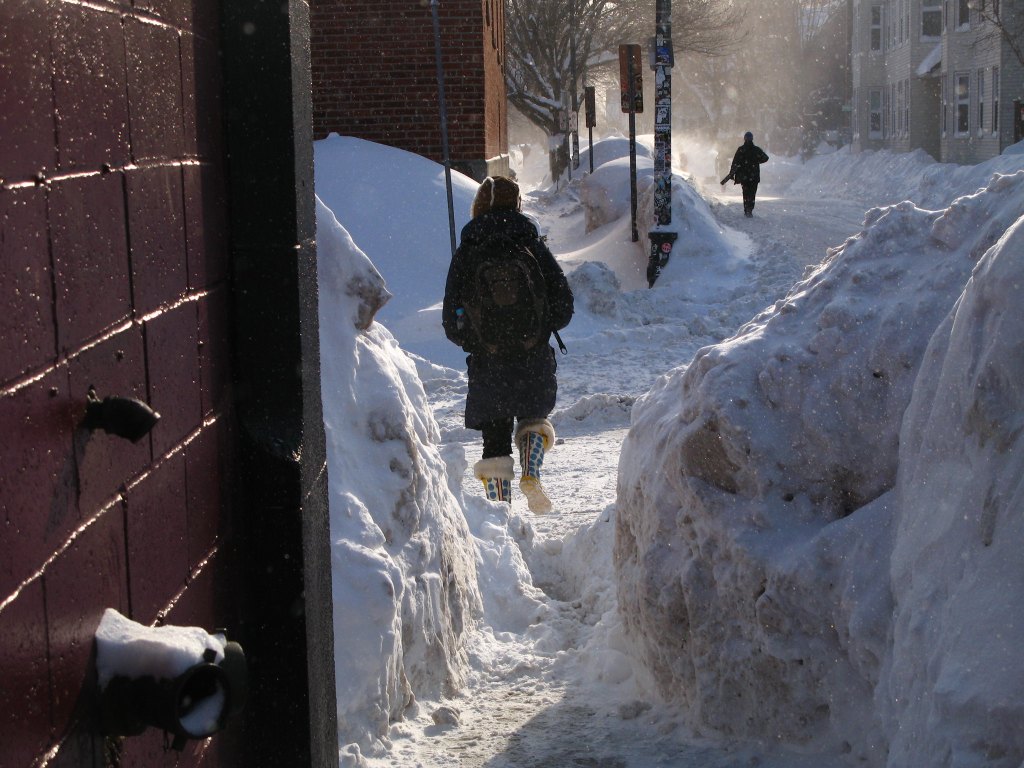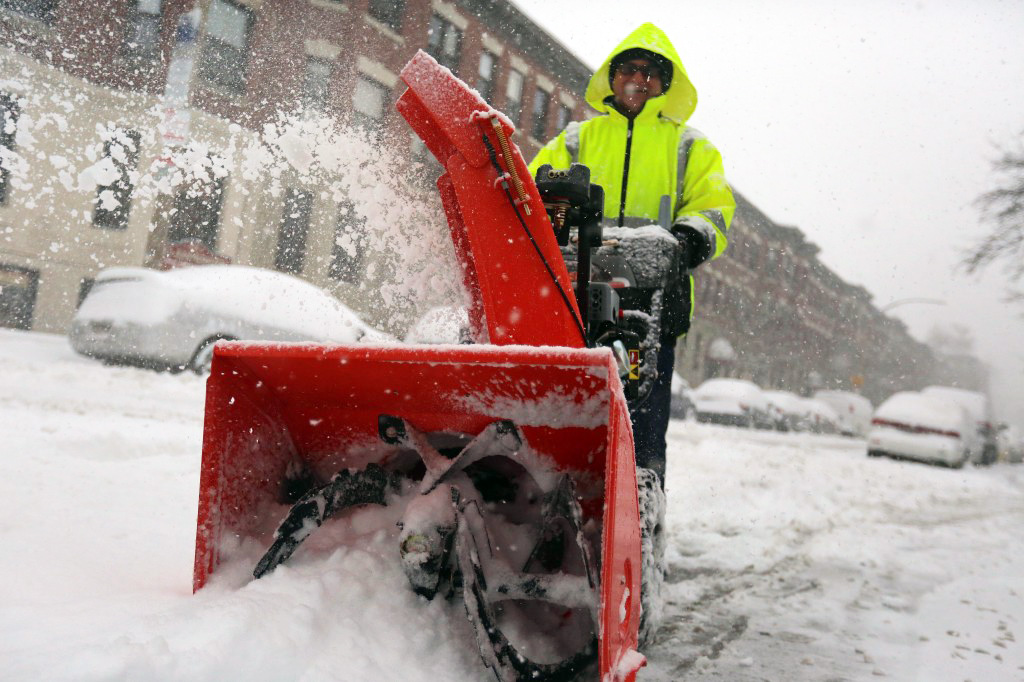It’s winter in Boston. The sun barely shines, your body tenses up every time you walk outside in the cold, and the storms can be terrible. Luckily, the brownstones look nice dusted with snow.
So I want to kick off this blog with something I think everyone can get behind – the city clearing your sidewalk for you.
Every time the city gets dumped on, snow plows come out to clear the streets for cars at taxpayers’ expense. The city of Boston’s snow removal budget is a whopping $24,788,143 for 2020, comprising 0.7% of the city’s $3,489,510,000 operating budget. I believe this includes limited sidewalk snow clearance for city owned buildings and public spaces, but not for residential or commercial real estate. To put it in perspective, the snow removal budget is about $40 per person, roughly the same as the Parks Department’s budget (26M) or half of what trash collection costs (50M).

Why does the city plow the streets? Because 45% of commuters drive to work, with 6% carpooling and 39% driving alone. Emergency services have to get around the city. Streets need to be clear for today’s society to function. People must be able to drive safely and efficiently, and it would be a pain for everyone to be responsible for clearing half the street outside their home.
However, 14% of Boston commutes on foot and 34% take transit (which starts and ends with walking), which is 48% total. Many drivers park on the street and have to walk to their cars, too. Pedestrian traffic is just as significant as vehicular traffic, and pathways also must be shoveled for emergencies. Society needs clear sidewalks to function. And just like if individuals were in charge of clearing their streets, requiring residents to clear their sidewalks causes a number of problems.
So why the disparity here? Why does the city only step in to help drivers? When you consider that one of Boston’s 2030 goals is to get more people to walk and take transit, the status quo where only the roads are cleared by the city looks even more illogical and unfair. Its another instance of society subsidizing cars over pedestrians, to the detriment of the planet. You can’t have a complete street without complete snow removal.
Check out any sidewalk in Boston when a snow storm moves through. Look at a high rise neighborhood like the financial district, an old mixed use neighborhood like the North End, or a quieter triple decker area like Dorchester. Snow is supposed to be cleared 3 hours after precipitation stops, or within 3 hours after sunrise if the storm stops over night, so up until that time each block can have wildly different conditions in front of each building. (Tough luck if you work the night shift, it’s snowing during rush hour, or the storm stops right after you leave for the day.) The larger and more professionally managed a building is, the more likely its snow removal will be done well, but you never know. Some sections of the sidewalk will be well shoveled as the snow is falling and there will be salt scattered to melt additional snowflakes. Others won’t get shoveled until the last minute, or maybe never at all. The snow can get packed down by pedestrians and form ice, which causes legitimate health and safety concerns. A 42″ wide stretch is supposed to be cleared for wheelchairs and strollers, but some people get lazy and figure a path the width of the shovel is fine. Walking down the street can feel too much like an expedition, particularly for the elderly and disabled.
The only way to ensure safe and equitable sidewalks is for the city to clear the snow.

I am not the first person to come up with the idea of municipal snow removal by any means, but I am doing what is probably the deepest dive on its benefits for a city like Boston.
The Benefits
Public health and safety is one of the main purposes of government. Being able to walk or move freely and safely down public ways is critically important. Citizens with limited mobility can be more than inconvenienced by snow or ice covered sidewalks, and even the fittest individuals can unexpectedly slip on ice and hurt themselves. Sometimes when the sidewalks aren’t clear pedestrians have to walk in the street, at a time when cars have less control and travel lanes are narrower! I will repeat my previous statement: the only way to ensure safe and equitable sidewalks is for the city to clear the snow.
This will also have the benefit of reducing liability for homeowners. If the city is responsible for clearing snow and ice, then you won’t be responsible if someone hurts themselves on the sidewalk outside your home. The contractor who is supposed to have cleared it will. It’s everyone’s worst nightmare to get sued by someone who slipped and fell on ice outside their building.
Shoveling snow manually is also physically demanding. Not everyone is up to the task, and even people who are can throw their backs out or have a heart attack. Emergency rooms prepare themselves for cardiac problems whenever snow piles up.
Municipal snow removal will also eliminate fines for residents, which are a flat rate and unfairly affect lower income families. The fine for failing to clear snow is $50 for a small building or $100 for buildings over 16 units. The 3 hour shoveling requirement applies to both an investment banker working a 16 hour day and a service worker holding down 3 jobs, but only one of them can afford professional snow removal or the fine for not getting the job done. If Boston’s taxes are truly progressive then snow removal in lower income neighborhoods will also be subsidized by wealthy neighborhoods and commercial buildings.
To get all Econ 101, sidewalks are a classic example of a public good: they are non-excludable and non-rivalrous, meaning no one can be prevented from using them and one person’s use of the sidewalks does not prevent others from using them. Maintenance of public goods is why taxes exist, and clearing a sidewalk so it can be used safely is just as important as building it in the first place. I’m not typically a big government guy, but this is one case where government intervention makes sense.
Lastly, economies of scale will make municipal snow removal more efficient, and everyone likes to save money.
How Snow Removal Contracts Work Now
The way most professional sidewalk snow removal works is that contracts are negotiated by individual buildings, or in the case of larger landlords and managers, possibly for a whole portfolio. The frontage and width of the sidewalk is calculated and prices are negotiated as a flat rate for the season, or on an inch by inch basis. Some contractors may offer package deals with other services like landscaping, or lower rates if they have other customers nearby since they’ll already be in the neighborhood.

The market doesn’t seem to be particularly efficient and prices vary wildly. A couple years ago I paid $130 flat for my share of my building’s snow removal, a price we had negotiated years earlier that hadn’t changed. Then the guy exited the industry so we each had to pay $400 flat for someone new. This year the second firm wanted to hike fees up to a whopping $750 per person, so we searched and found a third contractor to do it for an estimated $100 per person, but by the inch. Snowmageddon, the winter of 2015, caused many contractors to lose a lot of money on flat rate contracts, so prices went berserk afterwards, and only some contractors have brought them back down.
For single family houses, most people do the shoveling themselves. For two or three unit buildings, tenants often make deals with each other, or hope the other folks will do it.
This all creates a patchwork of responsibility for the removal of snow within each block.
On my block there are approximately 40 buildings and probably dozens of different snow removal contractors working. Many of the contracts are small enough that just one person comes with a shovel. The townhouse two doors down is always the last on the block to clear a path because the owners shovel it themselves. There is probably some potential upside to speaking with neighboring buildings about negotiating a larger, discounted snow removal contract, but this ignores the larger scale of the problem.
Economies of Scale
It would be far more efficient for one contractor to do an entire block and use better tools. Snow blowers and rotary brooms are much more effective than manual labor, although I do wish more were electric instead of gas powered. Once a snow blower is on site and running, the marginal cost to continue past the end of one building and do the whole side of the block is not high at all. The expensive part is getting the person and the snow blower, and then getting them to each site. When crews have to clear small sections of sidewalk and then walk or drive to another job, costs are much higher. Imagine if it was normal to work 1 hour at 8 different offices every day for a desk job. Even if they were all in the same neighborhood it would probably take 10 or 12 hours to do 8 hours of actual work. Consolidating snow removal contracts would save so much wasted time, effort and money.

I am not a procurement expert, but I believe the city should contract out sidewalk snow removal by block to the lowest bidder and make sure standards are set so sidewalks are cleared well and in a timely fashion. These contracts would probably get snatched up by the same people who already do work in the neighborhood, only everything would be more efficient. Consumers should see lower prices and contractors may make more money as costs go down and buildings that formerly self-shoveled get included in larger city contracts.
If $40 per capita can plow all the roads, it can’t be that much more expensive to clear all the sidewalks. Even if it would require budgeting $80 per resident per year, that would be a win. Property taxes are $10.54 per thousand for residential real estate and $25.00 for commercial in 2019, so raising them by a dime or two should be sufficient. Like I said, I already pay more than a hundred dollars a year, and some people out there are certainly paying more. If the roughly 300 residents on my block pay on average $100 each for snow removal, that’s $30,000. Assuming a savings of one third for the economy of scale, a $20,000 contract seems juicy enough to interest any company.
Since the fine for failing to clear snow just once is $50 for a small building or $100 for buildings over 16 units, some households may already spend more in fines. And if you really want to see some huge numbers, google the cost to settle a lawsuit after someone slips on ice.
Experiments with Municipal Snow Removal
Other cities are trying municipal snow removal to some extent. Syracuse, New York, the snowiest city in the US by some measures, started clearing important sidewalks and is expanding the program. It would have been nice if they’d started doing it while I went to undergrad there, especially my junior year when the city got 15 feet of snow, but better late than never.
Toronto and Burlington also clear lots of sidewalks. Vail and Aspen have heated streets for crying out loud. Municipal snow removal is an interesting enough idea that Citylab and Streetsblog covered it.
Its also worth talking about universities in snowy areas, many of which are small cities unto themselves, and they are beasts at snow removal. It makes perfect sense since residential universities are some of the only places where everyone walks. During my 4 years at Syracuse I believe the school only had one snow day, and it wasn’t even during the 15′ winter. As soon as the first flurries stuck, the grounds crew would zoom around with rotary brooms and sweep everything away. When I came to Boston I only saw this happening at other schools and in the financial district. I had to wonder, why don’t they do it everywhere in this city?

An Urban Snow Index?
If municipal sidewalk snow removal makes sense in Syracuse or Toronto, it should be a slam dunk in Boston. This is one of the densest snowy cities in the country, and with climate change we could see some more crazy winters. The state literally had to bring in reinforcements during Snowmageddon. It seems clear to me that the greater the population density and the more snow a city gets per year, the more efficient it is to have universal public snow removal contracts.
So I would like to propose a method of quantifying this since I don’t think one exists: an Urban Snow Index. In all honesty, I’m not very good at stats, but I think multiplying the average snowfall in inches by the urban population density per square mile and dividing by 1,000 is a good place to start. Perhaps the snowfall, the population density, or both, shouldn’t be weighted equally or have a linear effect on the index, but that would require a lot more work. I also have to emphasize urban density – some cities include lots of land around the perimeter that lowers the population density and would not be plowed, so its irrelevant. You can also do the calculation for only specific neighborhoods or the CBDs.
Lets look at what this index gives us for some places around America.
New York, NY 25*27,751/1000=693.7
Boston, MA 48*14,344/1000=688.5
Syracuse, NY 119.3*5,723/1000=682.7
Buffalo, NY 94.2*6,436/1000=606.2
Rochester, NY 94.3*5,885/1000=554.9
Toronto, Canada 48*11,226/1000=538.8
Chicago, IL 39.5*11,868/1000=468.7
Minneapolis, MN 50.4*7,821/1000=394.1
Burlington, VT 80.9*4,122/1000=333.4
Cleveland, OH 59.8*5,107/1000=305.3
Denver, CO 59.6*4,520/1000=269.3
Salt Lake City, UT 58.2*3,000/1000=174.6
Juneau, AK 99*1,750/1000=173.2
Princeton, NJ 24*1,600/1000=38.4
Honolulu, HI 0*5,791/1000=0
The results for this totally jive with my qualitative analysis and it seems like a good way of measuring the impact of snow in dense cities. Its probably not worth having the city clear the sidewalks in Cleveland or Denver (except for right downtown), but its definitely worth it in some of the super dense coastal cities like Boston and New York that get snow, and also the super snowy but only moderately dense cities in upstate New York. The cutoff is probably around USI 400 for it to be worth it to clear all the sidewalks in the city. Chicago and Minneapolis may want to think about it, too. But I digress.
OK Boston, Let’s Do This!
I’ve already made a weak attempt at taking this somewhere. I first reached out to Josh Zakim, my city councilor, and he didn’t do anything about it. I also talked to someone else in city hall, but she never heard back from the Public Works Department after she asked them to study it. Perhaps Kenzie Bok, my new councilor, will be interested. Neighborhood associations may also be interested in consolidating snow removal contracts.
Its easy to imagine alternative forms of this plan – only implementing it in certain neighborhoods, only having the city clear snow after a certain depth (like Rochester), or excluding commercial buildings.
If you think this is a good idea overall or have constructive feedback please let me know. Municipal sidewalk snow removal could make everyone’s life better for a relatively low cost. Perhaps we can get some momentum behind it. □